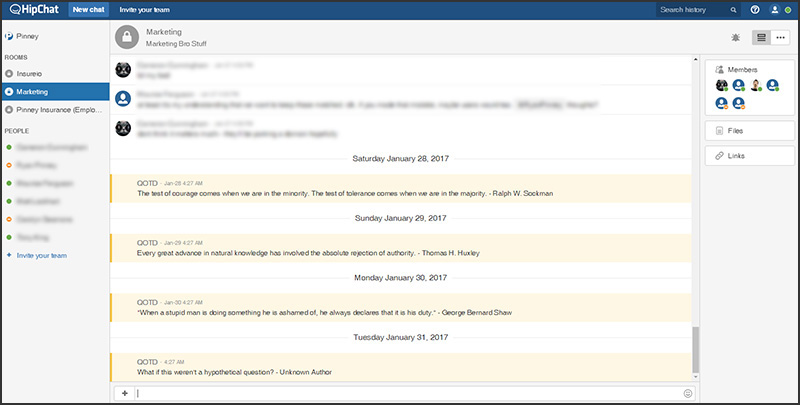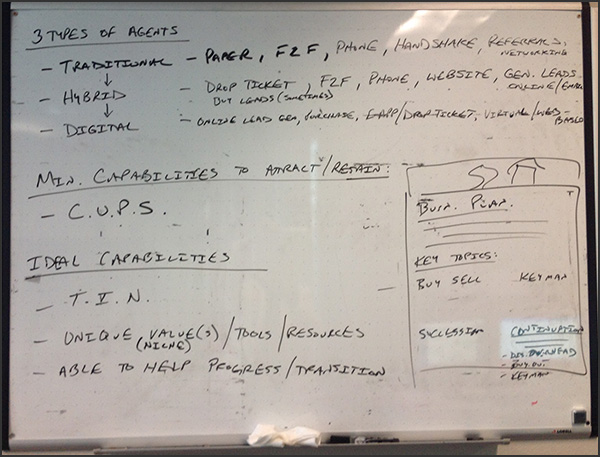
The internet is full of suggestions to supercharge your productivity. The irony is that we don’t have time to try them – sometimes making that change is just too disruptive to the day-to-day running of the business. Instead of recommending a big list of stuff you don’t have time to try, here’s our short list of three techniques that worked for Ryan.
The good news? Only one of these tips involves learning new software! The other two require you to think about how you attack your to-do list, and make changes accordingly. We all need to squeeze as much productivity as we can out of the 1,440 minutes we’re given each day. Sometimes the biggest gain comes from the ten minutes we spend thinking about the why instead of the how.
Here’s Ryan on the three changes he made in 2016 that skyrocketed his productivity.
Change #1: Start Using HipChat
Even with a filing system, this felt like a task rather than a way to get valuable information.
How many emails do you get on an average day? For me, it’s 300 – 500. Even if all I do is skim or delete, how much time do you think it takes to manage my email every day? Not to act on it, not to reply, forward, or answer it…but just to manage it. For me, it was hours. My inbox was out of control.
My first step was to reduce the number of emails I receive. I had already created filters to put newsletters and marketing emails in specific folders in Outlook, but I still had to browse those folders or mark them as read. If I was in a hurry, good content would get lost in the shuffle. In the end, even with a filing system, this felt like a task rather than a way to get valuable information. I kept a handful of the most valuable newsletters, and ruthlessly unsubscribed from the rest.
My second step was to transfer much of the conversation that happens over email to HipChat.
Unlike basic chat programs like Facebook Messenger or Google Hangouts, HipChat lets you create rooms that work perfectly for departments within a business. The account owner can add or remove members from the room as needed. Rooms are a great way to keep conversations both private and relevant. You can also message people one-on-one, like traditional chat software, and attach photos and documents.
Here's what the interface looks like:

Using HipChat lets me ask questions and get answers faster than by email. I can give updates and post announcements here and the whole team gets notified instantly. People can ask questions about whether a site is up, down, behaving weirdly, etc. The team can solve small problems together without the need for a complicated email chain and stream of reply-all responses.
This change reduced the number of emails I get by about 1,500 emails per month.
Don’t manage a huge volume of email? You can still streamline your process to save time and increase productivity. Here’s what to focus on:
- Do you have filters and folders set up that categorize your incoming email for you?
- Have you set aside time to unsubscribe to lists that are no longer valuable to you?
- Do you have a set time (or times) each day for checking and responding to email?
Change #2: Start Delegating
As you may know, 2016 was the year I started the transition from Pinney Insurance to Insureio. It’s not easy to get a new company off the ground when it’s your sole priority, but when you’re doing double-duty, it takes a lot of organization…and a lot of trust.
This is where I fell short.
I was doing a lot of micro-managing, especially when it came to our IT and marketing departments. What I didn’t realize was how much time this takes, and how it was hurting our productivity as a whole.
This workflow was holding everyone up…and I was the impediment.
I spent too much time doing things my teams could handle. Because I was taking this approach with multiple teams, I spent a lot of time answering questions. So many questions, in fact, that I’d have people from multiple teams waiting on me for answers to questions at any time. They couldn’t move forward until they got my answer. In reality, this workflow was holding everyone up…and I was the impediment.
I needed to do a better job of delegating to people that I knew were capable.
Step Back to Step Forward
Instead of typing out a long email with a new idea or assignment, I’d deliver it verbally and jot down key points on whiteboards.

Instead of creating a mock-up or prototype myself, I’d explain the goal and ask a team member to prepare what we call a “first 80” – a subject for a blog post all its own. In short, a “first 80” is a first draft that gets you 80% of the way to a completed task. By doing a better job of delegating and letting my team run with ideas, I stopped being the roadblock.
If you don’t manage a team, you can still look at your processes and make sure your time is being spent on the highest-level tasks:
- Are you spending time on tasks that could be automated?
- Are you spending time on tasks that could be outsourced?
- Do you use multiple programs that could be consolidated by learning or using new software?
Change #3: Double-Down on Your Niche & Address the Gap
This is another change that came out of managing my time during the transition between Pinney and Insureio. It’s about focusing your productivity and making sure you spend time on the projects that best suit your core strengths.
It’s easy to get distracted by shiny new things.
When it seems like everyone’s podcasting, for example, you might think you should, too. But what about three months later, when everyone’s offering one-on-one coaching? Should you drop the podcast and do that, too?
Are you already doing everything you can to serve your existing clientele?
If you get distracted too many times, you’ll end up with a set of projects that don’t serve your niche – your bread and butter. Before you implement any new project, product, or service, ask yourself: are you already doing everything you can to serve your existing clientele? Are there gaps in that market that aren’t being filled?
After considering these questions, we decided to double-down on what we do well—provide our partners with a process that works. But we decided to go about it in a way that addressed a gap in the market. Our upcoming Advanced Sales Academy is a result of this change in mindset.

We know our process works. But new agents and brokers who want to get into this space had nowhere to go for this type of process training, from the nuts-and-bolts of advanced sales techniques and phone scripts to the tech-oriented details about nurture emails and marketing automation. The education they needed was a gap – and we decided to fill it.
Here are the questions to ask yourself to see if there’s a gap in your niche:
- Have you created educational, promotional or marketing materials for clients, prospects, or partners? Would that material also be valuable to the rest of your audience?
- Have clients, prospects, or partners asked you the same question multiple times? If so, can you create an evergreen resource like a blog post or eBook that answers this question?
- What other resources do your clients, prospects, or partners use to get their questions answered? Do these resources cover material you do not? Is it a good idea for you to provide similar material?
We hope you found these tips and questions useful!
